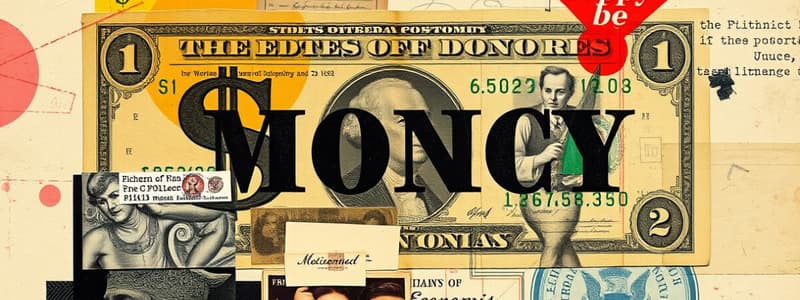Podcast
Questions and Answers
What is the difference between commodity money and fiat money?
What is the difference between commodity money and fiat money?
Commodity money involves the use of an actual good in place of money (gold coin, tobacco). Fiat money has no other value than as a medium for exchange; value comes from government (paper money).
What are the three functions of money? Which function is the defining characteristic?
What are the three functions of money? Which function is the defining characteristic?
The three functions are Medium for exchange, Unit of account, and Store value. The defining characteristic is the Medium for exchange.
What are the components of M1 and M2? List them.
What are the components of M1 and M2? List them.
M1 includes currency and checkable deposits. M2 includes M1 plus savings deposits, money market mutual funds, and small-demonination time deposits (CDs).
Suppose you withdraw $100 from your checking account. What impact would this action have on the following? (A) The money supply (B) Your bank's required reserves (C) Your bank's excess reserves.
Suppose you withdraw $100 from your checking account. What impact would this action have on the following? (A) The money supply (B) Your bank's required reserves (C) Your bank's excess reserves.
Why is the actual money multiplier usually less than the simple money multiplier?
Why is the actual money multiplier usually less than the simple money multiplier?
Why can't a bank lend out all of its reserves?
Why can't a bank lend out all of its reserves?
How does the Fed increase and decrease the money supply through open market operations?
How does the Fed increase and decrease the money supply through open market operations?
How is the discount rate different from the federal funds rate?
How is the discount rate different from the federal funds rate?
What is the current required reserve ratio? What would happen to the money supply if the Fed decreased the ratio?
What is the current required reserve ratio? What would happen to the money supply if the Fed decreased the ratio?
Define quantitative easing. How is it different from standard open market operations?
Define quantitative easing. How is it different from standard open market operations?
Flashcards are hidden until you start studying
Study Notes
Money Definitions and Types
- Commodity Money: Uses tangible goods (e.g., gold, tobacco) as currency.
- Fiat Money: Has no intrinsic value; its worth is derived from governmental decree (e.g., paper money).
Functions of Money
- Medium of Exchange: Facilitates trade by eliminating the need for barter.
- Unit of Account: Provides a standard measure to quote prices, facilitating value comparison in transactions.
- Store of Value: Allows individuals to preserve wealth over time (less effective today due to the prevalence of bank accounts).
Money Supply Measures
- M1 Components: Includes currency in circulation and checkable deposits.
- M2 Components: Comprises M1 plus savings deposits, money market mutual funds, and small-demonination time deposits (e.g., CDs).
Bank Reserves and Money Supply
- Impact of $100 Withdrawal:
- Decreases money supply by $100.
- Reduces required reserves of the bank.
- Increases excess reserves of the bank.
Money Multiplier
- Actual vs. Simple Money Multiplier:
- Actual money multiplier is usually lower due to factors like un-deposited currency and banks holding excess reserves.
- Simple money multiplier represents the theoretical maximum increase in money supply based on reserve ratios.
Bank Lending Regulations
- Banks are legally required to maintain a fraction of deposits as reserves, limiting the amount of funds available for lending. This ensures liquidity for depositors.
Federal Reserve Operations
- Open Market Operations:
- Increase Money Supply: Fed purchases US Treasury securities.
- Decrease Money Supply: Fed sells US Treasury securities.
Interest Rates in Banking
- Discount Rate: The interest rate for loans from the Fed to private banks.
- Federal Funds Rate: The interest rate for loans between private banks.
Reserve Ratio Implications
- Current Required Reserve Ratio: 10% (0.10).
- A decrease in the reserve ratio would enhance the money multiplier effect, thus increasing the overall money supply.
Quantitative Easing
- Definition: A form of open market operation targeting specific long-term securities rather than just short-term assets.
- Difference from Standard Operations: Focuses on troubled markets and long-term Treasury securities to stimulate the economy.
Studying That Suits You
Use AI to generate personalized quizzes and flashcards to suit your learning preferences.




